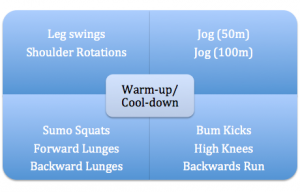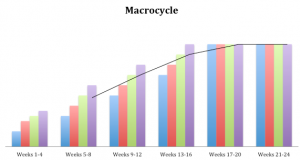Meet Joanne Smith,
This training program was developed for Joanne, a 35 year old female whose main goals are to lose ~10 lbs within a six month period and to successfully complete a half marathon at the end of the six months. She does not currently attend a gym, and has very little experience in resistance training exercises. We begin each individual experience with a physical assessment to determine strengths and weaknesses, along with establishing short and long term goals to provide a specialized and specific program for success.
Joanne’s goals:
- Short-term goal (1 month) = Increase her muscular strength to lose at least half of her desired weight of 10 lbs.
- Long-term goal (6 month) = Increase her aerobic endurance to complete a half marathon (21.09 kilometres), and to lose the remaining weight.
Before any training program begins, a trainer will perform assessment tests to define the client’s baseline fitness, alongside strengths and weakness’ in order to develop an appropriate and effective program.
These are the physical assessment tests used for Joanne at the beginning of her program. Also tested was her heart rate at rest (HRrest), Heart Rate max (HRmax), VO2max and blood pressure.
As part of Joanne’s assessment, we used the Cooper test to monitor the development of her aerobic endurance and to obtain an estimate of her VO2max. With this information, we are able to develop her endurance portion of the program for 6 months and with continuous re-testing, we are able to make adjustments if needed. We tested Joanne’s predictive 1 Rep Max (RM) for leg press to evaluate her initial leg strength. This shows us her starting point, allowing us to develop her resistance plan. Furthermore, it helps us prescribe appropriate exercise types and loads to increase her leg strength and endurance in order to sustain the demands of running over 21km. Body composition for Joanne is a pivotal aspect throughout her program. Her short-term goal is to lose weight, therefore, by measuring her initial percentage of body fat, waist circumference, and body mass index (BMI), we are able to prescribe appropriate resistance exercises, intensities and loads to put her in a healthy body fat range and accomplish her goals. Body composition aids in her long-term goal of finishing a half marathon as well.
The Cooper test will be retested roughly every 2 months to determine progress with speed and endurance capability with Joanne’s VO2max scores. The 1-RM leg press test and body composition tests will be conducted more frequently, every two weeks, as we suspect increases to be greater and occur at a faster rate than her aerobic endurance. Her goals are to increase muscular strength, to lose her desired weight and to improve her aerobic endurance to complete a half marathon, therefore, these tests will all contribute to determining development and progress of her program.
Each program consists of warm-up and cool-down exercises based upon the clients goals. Warm-ups are important to decrease the risk of injury or re-occurance of previous injuries. Physiologically, warming up assists circulation throughout the body in order to pump sufficient oxygenated blood to the working muscles during the workout period. It will increase your heart rate slightly to raise your core body temperature. This allows full range of motions within joints and prevents muscle tears and pulls. A proper warm up will safely prepare an individual for the increased demands of exercise. Cool-downs are important to recover gently. Your heart rate will be elevated after exercises and therefore it reduces your heart rate back to resting levels gently while circulating blood throughout the body in sufficient quantities to decrease the lactic acid build up in your muscles along with other metabolic wastes produces during exercise. Blood pooling can occur in your extremities after aerobic exercises rather than returning to your heart, which causes dizziness and nausea, making cool-downs ideal for proper recovery.

These are example exercises of Joanne’s program that are to be performed as a warm-up and/or a cool-down. Not all exercises need to be performed each session; they can be cycled to keep variation between workouts each day.
Using the above fitness assessments, the following exercise program was created for Joanne based on her results and goals. This program has been developed to focus on 3 key areas.
- Muscular Endurance: Allowing us to focus on the goal of weight loss as well with long distance running.
- Muscular strength: Contributing to weight loss, while most importantly assisting in the goal of long distance running.
- Aerobic endurance: Focuses on the long term goal of completing a half marathon.
Joanne’s Macrocycle consists of season 1, a 6 month program, and is able to have 2 seasons within the year.
The above Macrocycle shows Joanne’s muscular strength gains over a 6 month period. A steady increase from week 1 to the end of week 16, after which a plateau occurs from week 17 to 24. This plateau occurs because once Joanne hits her peak strength, she accomplished her weight loss goal, and therefore, the weeks following show the maintenance aspect of her program. This portion of her program was based strictly on strength and maintenance of gains accomplished.

This 6 month macrocycle shows Joanne’s linear increase towards her goal of completing a half marathon. .
This 6 month Macrocycle shows the steady increase in long distance running performance accomplished; Joanne’s increased aerobic endurance over her 6 month program. Joanne’s assessment stated she was able to run 5km, being winded by the end. As she worked through this program, Joanne was able to accomplish running over 21km due to her increased aerobic endurance by running longer distances and improving her VO2max.
To view each month of Joanne’s 6 month program tailored for her specific goals, please click the links below:
- Joanne’s active rest days include, but are not limited to, gardening, walking, yoga/stretching (at home) or a class offered in our facility. This allows for the development of flexibility throughout her program and decrease the likelihood of injury. Active rest days are not intended to be as intense as resistance days.
- Before each long distance run, Joanne performs a warm-up and a dynamic stretch that helps prevent injury and other complications. Following her long distance runs she performs a cool-down and a static stretch to prevent injury and delayed onset muscle soreness which can inhibit next day(s) training.


